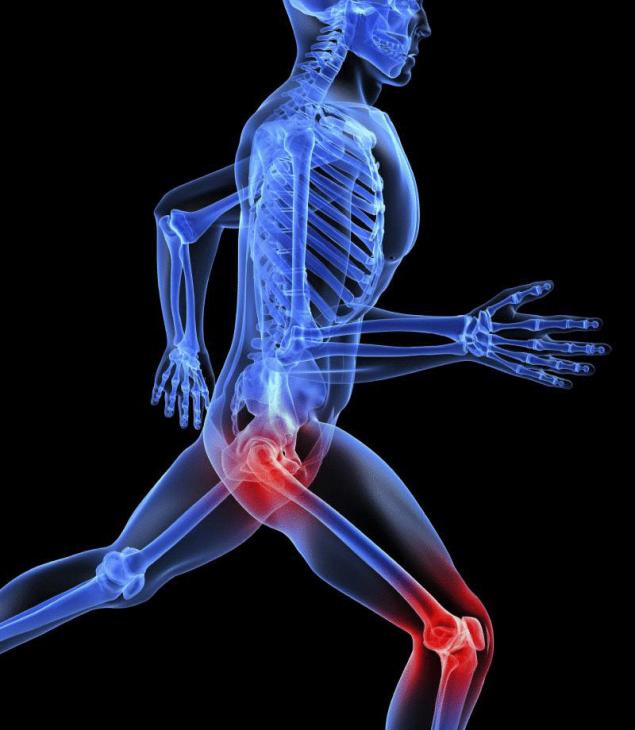863
Why crackle joints and how to fight it
The sounds that emit our joints do not always indicate disease. Often, they are harmless. How to distinguish one from the other? Have you ever heard crackling in the knees, taking a standing position? And what about the joints of the shoulder girdle? They creak when you lift and drop your shoulders? Or perhaps you're familiar with clicks of the hip in sports? Surely the answer is yes to at least one of these questions. All this "music" of the body can lead to confusion and cause to reflect on the campaign to the doctor.

However, experts say that most of them are harmless sounds. Still, some of them - evidence of disease
. In
ORDER OF THINGS "Anyone, even a healthy joint may produce different sounds. By itself, the sound - still not an indication of pathology, "- says Valery Alpatov, MD, traumatologist
highest category. But if the joint is perfectly well why he snaps?
British doctors have put forward his theory of the emergence of sound in healthy joints. According to this theory, clicks and other sounds arise from the accumulation of gases in the synovial fluid which fills the joint, acting as a shock absorber and lubricant. The mechanism of action in this case is that a sharp joint capsule stretching (due to, for example, improper movement) it decreases pressure due to gas bubbles are produced in the synovial fluid. When these bubbles burst, we hear a distinctive sound.
But our doctors are finding that explanation absurd: "If in the synovial fluid and the bubbles are formed, then small. They physically can not make a sound. It is impossible, "- says Artak Matsakyan, MD, a practicing orthopedic traumatologist
. OPTION
STANDARDS These sounds in the joints themselves, for example in the joints of feet, may occur when cresting sprawling adipose tissue from the femur or tibia. In the knee a sound during movement can be caused by hitting the synovial membrane that lines the inside of the joint, between the cup and the thigh.
The sounds, which we think are formed in the joints can also occur outside the joint at the overlap of the tendons and ligaments. When ligaments and tendons take its original position, the characteristic sound is produced. Such overlap is not a threat to health and is the physiological norm.
Interestingly, some people snap joints constantly, while others almost never faced with such a problem. This feature is explained by doctors weak ligamentous apparatus. As a connecting element, ligament attaches the bones together. One of its functions is to restrict the mobility of joints, to control the range of motion.
Weak ligaments leads to hypermobility of joints, they are becoming more mobile, and the ligaments themselves often overlapped. Hence the sound. Joint hypermobility is not an aberration, but still people with weak ligaments need to be careful, as this feature is often the cause dislocations and subluxations.
SIGNAL LIGHTS
If the sounds are not accompanied by pain, most likely, they are harmless. Anxiety is hit when there is pain, numbness or a "blockade". All this indicates damage at the joint or periarticular tissues. In this case you should immediately consult a doctor.
Injuries.
Clicks and crackle in the joints accompanied by pain and "blockade", may occur after an injury - damage to the cartilage, meniscus, torn ligaments. In a complete break of the ligament of her chattering may fall between the joint surfaces, making the sound by blocking the joint and causing pain. Some joints are affected more frequently than others - hip, knee joints, and joints of the shoulder girdle
. Osteochondral body.
Sometimes there is sound in the joint because of the presence of free osteochondral body. These bodies appear as a result of injury or some diseases. Moving freely within the joint, they m
can produce a sound that is always accompanied by pain, and sometimes the "blockade».
Osteoarthritis.
Crunch in the joints accompanied by pain, may indicate osteoarthritis. This sound occurs when the joint surfaces rub against each other. However, arthrosis is not always accompanied by the sound. Just like the sound is not always accompanies osteoarthritis.
JOINTS TO BE HEALTHY
We can not force your joints completely "silent." Especially when it comes to hypermobility. However, we can strengthen the muscles surrounding the joint, make sure that the joints in good working order and, as a consequence, less crackling.
1 / regularly engaged in fitness
Overweight - the first enemy to your joints. Just one extra kilogram increases the load on the surface of the cartilage, and in the end joints hurt and crackle. To maintain joint American Academy of Orthopaedic Surgeons (AAOS) recommends that play sports for at least 30 minutes a day. Thus it is necessary to make sure that the loads are moderate, with no encumbrances.
It is not necessary to resort to using slozhnosochinennogo sets of exercises. Suit and walking and cycling, and tennis. If you have a problem with overweight, choose swimming, where the load on the joints is almost absent. Otherwise, you only hurt yourself, because extra weight mercilessly "beat" on the joints during workouts. Once the excess weight goes, enter exercise on land.
2 / Eat right
A diet rich in vitamins and trace elements, helps you to strengthen the bones and joints. The basis of bones and ligaments are mucopolysaccharides. They are involved in the synthesis and formation of cartilage synovial fluid. Support your body, you can, by introducing into the diet foods rich in polysaccharide - jellies, Jellied meats, hearty soups. Important in their preparation - not to remove the cartilage and bone, rich mucopolysaccharides. For dessert, cook jelly or jelly, which also contains the valuable carbohydrate.
3 / If you want your knees are healthy, choose the right shoes.
Shoes with high heels and flat shoes redistribute the load in the knee joint. He wears out faster, pop nachinaeya match. Ideal -. Shoes on a wide heel height of 3-4 cm If you have to spend all day in high heels, buy a special orthopedic insole. This insole supports the arch of the foot, while being completely invisible.
5 products for strong bones and joints
Milk and dairy products.
Contains the highest amount of calcium. Furthermore, these products without the person can not obtain the required dietary calcium.
Greenery.
It is rich in essential vitamin C, B1, B2, K, E and contains valuable minerals such as calcium, potassium, iron, phosphorus, which is essentially - a mineral and vitamin complex
. Marine fish, eggs, liver and quail eggs.
These foods are rich in vitamin D, which enhances the absorption of calcium, needed for bone health.
Black currant, wild rose and citrus.
Ascorbic acid deficiency leads to disruption of the synthesis of bone collagen, thus introducing into the diet foods rich in vitamin C.
Jelly-like dishes and soy.
These products are rich in essential amino acid such as lysine. Lysine is involved in the Costa formation and maintenance of function of cartilage in the joints.
Practising joints
The joint exercises aimed at the prevention of diseases of the musculoskeletal system. It will help relieve the tension. Doing it regularly, you will be less tired.
TRAINING PLAN
Perform complex every day (at least - 5 times a week), making it 3-6 repetitions of each exercise. At the end of the complex sit on a chair, relax your muscles and breathe deeply for 1 minute.
1 Train
wrists Work wrist muscles.
Stand with your feet shoulder width apart. Straighten your arms at shoulder level, fingers look down. Pull your fingers over, stay in the point of maximum voltage for 10 seconds. Relax your hand. Make 4 repeat.
2 Stretch the spine
Work back muscles, shoulders and arms.
Stand with feet shoulder-width apart, arms down down, hands linked in the lock, chin pressed against his chest, his back arched. Hands pull down his neck - up. Hold voltage at 15 seconds. 4 Perform repeat.
3 Spins hands
Work shoulder muscles, hands.
Spread the arms to the sides at shoulder level, forearm omitted. Rotate the forearm clockwise for 20 seconds. Repeat the rotation in the other direction. Perform 3 repetitions.
4 Deflections back
They work the muscles of the lumbar back.
Feet shoulder width apart, looking down his chin. Uprites fists in the small of the back. By submitting your elbows together, cave ahead. Hold for 15 seconds. 4 Perform repeat.
5 Stretching the spine
Work your abs and back.
Feet shoulder width slightly bent at the knees, his chin pressed against his chest. Stretch forehead down, sending up a groin. Then linger voltage at 15 seconds. Perform 3 repetitions.
6 Stretching coccyx
Work muscles of the thighs, the buttocks and the lumbar back.
Feet shoulder width apart, knees slightly bent, hands lie on the thighs. Stretch the coccyx to the neck. Hold for 15 seconds and repeat 3 Perform.

However, experts say that most of them are harmless sounds. Still, some of them - evidence of disease
. In
ORDER OF THINGS "Anyone, even a healthy joint may produce different sounds. By itself, the sound - still not an indication of pathology, "- says Valery Alpatov, MD, traumatologist
highest category. But if the joint is perfectly well why he snaps?
British doctors have put forward his theory of the emergence of sound in healthy joints. According to this theory, clicks and other sounds arise from the accumulation of gases in the synovial fluid which fills the joint, acting as a shock absorber and lubricant. The mechanism of action in this case is that a sharp joint capsule stretching (due to, for example, improper movement) it decreases pressure due to gas bubbles are produced in the synovial fluid. When these bubbles burst, we hear a distinctive sound.
But our doctors are finding that explanation absurd: "If in the synovial fluid and the bubbles are formed, then small. They physically can not make a sound. It is impossible, "- says Artak Matsakyan, MD, a practicing orthopedic traumatologist
. OPTION
STANDARDS These sounds in the joints themselves, for example in the joints of feet, may occur when cresting sprawling adipose tissue from the femur or tibia. In the knee a sound during movement can be caused by hitting the synovial membrane that lines the inside of the joint, between the cup and the thigh.
The sounds, which we think are formed in the joints can also occur outside the joint at the overlap of the tendons and ligaments. When ligaments and tendons take its original position, the characteristic sound is produced. Such overlap is not a threat to health and is the physiological norm.
Interestingly, some people snap joints constantly, while others almost never faced with such a problem. This feature is explained by doctors weak ligamentous apparatus. As a connecting element, ligament attaches the bones together. One of its functions is to restrict the mobility of joints, to control the range of motion.
Weak ligaments leads to hypermobility of joints, they are becoming more mobile, and the ligaments themselves often overlapped. Hence the sound. Joint hypermobility is not an aberration, but still people with weak ligaments need to be careful, as this feature is often the cause dislocations and subluxations.
SIGNAL LIGHTS
If the sounds are not accompanied by pain, most likely, they are harmless. Anxiety is hit when there is pain, numbness or a "blockade". All this indicates damage at the joint or periarticular tissues. In this case you should immediately consult a doctor.
Injuries.
Clicks and crackle in the joints accompanied by pain and "blockade", may occur after an injury - damage to the cartilage, meniscus, torn ligaments. In a complete break of the ligament of her chattering may fall between the joint surfaces, making the sound by blocking the joint and causing pain. Some joints are affected more frequently than others - hip, knee joints, and joints of the shoulder girdle
. Osteochondral body.
Sometimes there is sound in the joint because of the presence of free osteochondral body. These bodies appear as a result of injury or some diseases. Moving freely within the joint, they m
can produce a sound that is always accompanied by pain, and sometimes the "blockade».
Osteoarthritis.
Crunch in the joints accompanied by pain, may indicate osteoarthritis. This sound occurs when the joint surfaces rub against each other. However, arthrosis is not always accompanied by the sound. Just like the sound is not always accompanies osteoarthritis.
JOINTS TO BE HEALTHY
We can not force your joints completely "silent." Especially when it comes to hypermobility. However, we can strengthen the muscles surrounding the joint, make sure that the joints in good working order and, as a consequence, less crackling.
1 / regularly engaged in fitness
Overweight - the first enemy to your joints. Just one extra kilogram increases the load on the surface of the cartilage, and in the end joints hurt and crackle. To maintain joint American Academy of Orthopaedic Surgeons (AAOS) recommends that play sports for at least 30 minutes a day. Thus it is necessary to make sure that the loads are moderate, with no encumbrances.
It is not necessary to resort to using slozhnosochinennogo sets of exercises. Suit and walking and cycling, and tennis. If you have a problem with overweight, choose swimming, where the load on the joints is almost absent. Otherwise, you only hurt yourself, because extra weight mercilessly "beat" on the joints during workouts. Once the excess weight goes, enter exercise on land.
2 / Eat right
A diet rich in vitamins and trace elements, helps you to strengthen the bones and joints. The basis of bones and ligaments are mucopolysaccharides. They are involved in the synthesis and formation of cartilage synovial fluid. Support your body, you can, by introducing into the diet foods rich in polysaccharide - jellies, Jellied meats, hearty soups. Important in their preparation - not to remove the cartilage and bone, rich mucopolysaccharides. For dessert, cook jelly or jelly, which also contains the valuable carbohydrate.
3 / If you want your knees are healthy, choose the right shoes.
Shoes with high heels and flat shoes redistribute the load in the knee joint. He wears out faster, pop nachinaeya match. Ideal -. Shoes on a wide heel height of 3-4 cm If you have to spend all day in high heels, buy a special orthopedic insole. This insole supports the arch of the foot, while being completely invisible.
5 products for strong bones and joints
Milk and dairy products.
Contains the highest amount of calcium. Furthermore, these products without the person can not obtain the required dietary calcium.
Greenery.
It is rich in essential vitamin C, B1, B2, K, E and contains valuable minerals such as calcium, potassium, iron, phosphorus, which is essentially - a mineral and vitamin complex
. Marine fish, eggs, liver and quail eggs.
These foods are rich in vitamin D, which enhances the absorption of calcium, needed for bone health.
Black currant, wild rose and citrus.
Ascorbic acid deficiency leads to disruption of the synthesis of bone collagen, thus introducing into the diet foods rich in vitamin C.
Jelly-like dishes and soy.
These products are rich in essential amino acid such as lysine. Lysine is involved in the Costa formation and maintenance of function of cartilage in the joints.
Practising joints
The joint exercises aimed at the prevention of diseases of the musculoskeletal system. It will help relieve the tension. Doing it regularly, you will be less tired.
TRAINING PLAN
Perform complex every day (at least - 5 times a week), making it 3-6 repetitions of each exercise. At the end of the complex sit on a chair, relax your muscles and breathe deeply for 1 minute.
1 Train
wrists Work wrist muscles.
Stand with your feet shoulder width apart. Straighten your arms at shoulder level, fingers look down. Pull your fingers over, stay in the point of maximum voltage for 10 seconds. Relax your hand. Make 4 repeat.
2 Stretch the spine
Work back muscles, shoulders and arms.
Stand with feet shoulder-width apart, arms down down, hands linked in the lock, chin pressed against his chest, his back arched. Hands pull down his neck - up. Hold voltage at 15 seconds. 4 Perform repeat.
3 Spins hands
Work shoulder muscles, hands.
Spread the arms to the sides at shoulder level, forearm omitted. Rotate the forearm clockwise for 20 seconds. Repeat the rotation in the other direction. Perform 3 repetitions.
4 Deflections back
They work the muscles of the lumbar back.
Feet shoulder width apart, looking down his chin. Uprites fists in the small of the back. By submitting your elbows together, cave ahead. Hold for 15 seconds. 4 Perform repeat.
5 Stretching the spine
Work your abs and back.
Feet shoulder width slightly bent at the knees, his chin pressed against his chest. Stretch forehead down, sending up a groin. Then linger voltage at 15 seconds. Perform 3 repetitions.
6 Stretching coccyx
Work muscles of the thighs, the buttocks and the lumbar back.
Feet shoulder width apart, knees slightly bent, hands lie on the thighs. Stretch the coccyx to the neck. Hold for 15 seconds and repeat 3 Perform.
When I learned not to judge ...
If you want to keep your body free from fungi, do not give them food!























